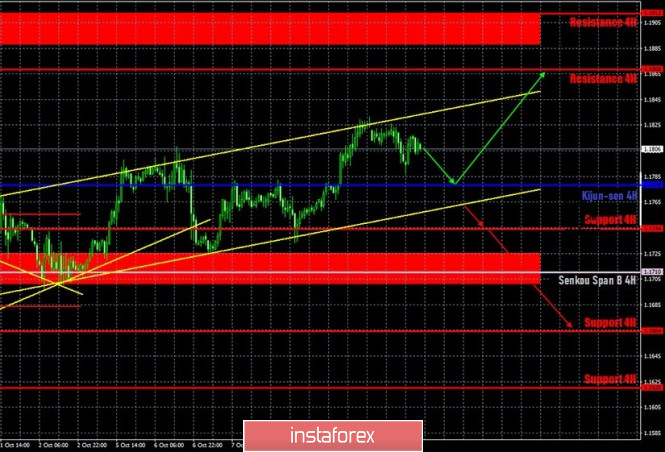EUR/USD 1H

The EUR/USD pair began to correct on the hourly timeframe on October 12, rebounding off the upper line of the ascending channel. Thus, the pair's quotes have an excellent opportunity to go down to the Kijun-sen line or even to the lower channel line. This option is absolutely possible given the nature of the pair's movement last week. At the same time, as long as the price continues to move within the channel, the upward trend remains. It is not too strong, we have already said that traders are afraid of making new critical longs on the euro around its two-year highs and they are also cautious due to the words of the European Central Bank representatives about the "too high rate". Bears see no reason or reason to sell the currency pair, given the fundamental backdrop from America.
EUR/USD 15M

The lower linear regression channel turned to the downside on the 15-minute timeframe, which fully corresponds to the picture of what is happening on the hourly timeframe. Thus, there are signs of starting a downward correction, respectively, on the hourly timeframe, the pair may go down to the two designated targets.
COT report

The EUR/USD pair has risen in price by about 120 points during the last reporting week (September 29 - October 5). But in general, there are still no significant price changes for the pair. In fact, all trades are held in a horizontal range of 250-300 points. Thus, data from any Commitment of Traders (COT) report can only be used for long-term forecasting. The latest COT report showed that non-commercial traders, which we recall, are the most important group of traders in the forex market, closed 10,784 Buy-contracts (longs) and opened 2,078 Sell-contracts (shorts). Take note that two weeks earlier, the "non-commercial" group was relatively active in building up long positions, but now it is decreasing its net position for the second consecutive week. This may indicate that the upward trend for the pair is over. Or it is about to end. We have already said that the lines of the net positions of the "commercial" and "non-commercial" groups (upper indicator, green and red lines) diverge strongly when a trend change occurs. If this is the case, the peak point of the upward trend will remain at $1.20. The net position of non-commercial traders was at its highest (green line) at this point. After reaching this level, it falls steadily. Thus, the pair may try to make another upward breakthrough as a final assault on the bulls, but you should hardly expect the pair to go much higher than the 20 figure.
No macroeconomic background for EUR/USD on Monday, October 12, although ECB President Christine Lagarde delivered a speech. However, this time her speech at the video conference was not devoted to the monetary policy of the ECB, but to the possible creation of a digital euro. According to Lagarde, a final decision on this issue has not yet been made, and the digital euro is in no way seen as a replacement for fiat money, but only as an addition to it. Lagarde believes that the process of creating an electronic state currency will be very laborious and slow, but in the end, the electronic euro will be much more profitable than printed money, and at the same time it will be much faster, cheaper and safer. There were no other important messages and macroeconomic reports that day. Thus, quiet trading with volatility of no more than 40 points is absolutely logical and easy to explain.
We have two trading ideas for October 13:
1) The pair continues to trade within the ascending channel, which has a small slope. In other words, the upward trend is not strong and with frequent corrections. Thus, buyers can continue to trade the pair upward while aiming for 1.1868 and the resistance area at 1.1888-1.1912 as long as the price is above the Kijun-sen line (1.1778). Take Profit in this case will be up to 80 points. You can open new longs in case the price rebounds from the critical line.
2) Bears are not in control of the market at the moment. Thus, sellers need to wait for the next chance and get the price to settle below the rising channel to be able to open new short positions while aiming for the Senkou Span B line (1.1710). In this case, the potential Take Profit is up to 40 points. Further downward movement will entirely depend on overcoming the Senkou Span B.
Explanations for illustrations:
Support and Resistance Levels are the levels that serve as targets when buying or selling the pair. You can place Take Profit near these levels.
Kijun-sen and Senkou Span B lines are lines of the Ichimoku indicator transferred to the hourly timeframe from the 4-hour one.
Support and resistance areas are areas from which the price has repeatedly rebounded off.
Yellow lines are trend lines, trend channels and any other technical patterns.
The material has been provided by InstaForex Company - www.instaforex.com














 Download NOW!
Download NOW!
No comments:
Post a Comment